Michael Allen Schweitzer, M.D.
- Director, Johns Hopkins Center for Bariatric Surgery
- Associate Professor of Surgery

https://www.hopkinsmedicine.org/profiles/results/directory/profile/0017728/michael-schweitzer
Quetiapine dosages: 300 mg, 200 mg, 100 mg, 50 mg
Quetiapine packs: 30 pills, 60 pills, 90 pills, 120 pills, 180 pills, 270 pills, 360 pills

Discount 200 mg quetiapine mastercard
Sixty-two percent required both indwelling catheters or external amassing units for urinary maintenance. Urinary incontinence was associated with poor useful status and bilateral lesions, whereas urinary retention was more generally noted in sufferers with comorbid diabetes mellitus or fecal impaction. The urinary incontinence is secondary to detrusor overactivity with synergic sphincters (Blaivas, 1985;Krzasteketal. Cerebrospinalfluidshunting,primarily through a ventriculoperitoneal shunt, is the mainstay of therapy and can result in scientific enchancment of urinary symptoms, particularly urinary urgency and urge incontinence (Krzastek et al. Affected kids exhibit delayed gross motor growth, irregular motor efficiency, altered muscle tone, abnormal posture, and exaggerated reflexes. Those youngsters who do attain daytime and nighttime continence achieve this at a higher median age compared with regular controls (Wright et al. Incontinence (74%), urinary frequency (56%), and urgency (37%) were the commonest presenting signs, and detrusor overactivity was the most common urodynamic abnormality (87% of these undergoing urodynamics), with 25% of those exhibiting obvious striated sphincter dyssynergia. Incontinence was the major presenting symptom within the other half, with related detrusor overactivity in 14 of 16. The areas most regularly concerned with related micturition dysfunction are the superior features of the frontal lobe (Blaivas, 1985). In common, clean and striated sphincters are synergic, whereas pseudodyssynergia could occur throughout urodynamic testing. In a evaluation of frontal lobe lesions and bladder control, Fowler (1999) cites instances of improvement of micturition symptoms for a period of time after tumor resection, raising the query of whether or not the phenomenon of tumor-associated bladder overactivity was a constructive one (activating some system) rather than a adverse one (releasing a system from control). Urinary retention has also been described in sufferers with space-occupying lesions of the frontal cortex, within the absence of different related neurologic deficits (Lang et al. Posterior fossa tumors may be related to voiding dysfunction (32% to 70%, based on references cited by Fowler, 1999). Retention or difficulty voiding is the rule, with incontinence being a rare discovering. Cerebellar Ataxia Cerebellar ataxia is a gaggle of diseases involving pathologic degeneration of the nervous system, often involving the cerebellum however Chapter 116 was reported in 17 of 23 sufferers younger than 20 years of age and in 4 of 10 older than 20. The extra critical manifestations, similar to retention, have been found only in the adults, prompting the authors to recommend that problem urinating may progress in adulthood. Socialcontinence was extremely associated with bigger capability bladder with lower storage pressures (presumably improved compliance), lack of uninhibited contractions, and coordinated (lack of pseudodyssynergia) sphincter exercise.

Purchase quetiapine 50 mg otc
Johnson A, Sudarshan S, Liu J, et al: Feasibility and outcomes of repeat partial nephrectomy, J Urol 180(1):89�93, discussion ninety three, 2008. Kawauchi A, Yoneda K, Fujito A, et al: Oncologic consequence of hand-assisted laparoscopic radical nephrectomy, Urology 69(1):53�56, 2007. Fornara P, Doehn C, Jocham D: Laparoscopic nephropexy: 3-year expertise, J Urol 158(5):1679�1683, 1997. Gilbert D, Abaza R: Robotic excision of recurrent renal cell carcinomas with laparoscopic ultrasound assistance, Urology 85(5):1206�1210, 2015. Chapter 102 within the surgical management of renal tumors, J Urol 185(3):1150�1154, 2011. Landman J, Lento P, Hassen W, et al: Feasibility of pathological analysis of morcellated kidneys after radical nephrectomy, J Urol 164(6):2086�2089, 2000. Landman J, Venkatesh R, Lee D, et al: Renal hypothermia achieved by retrograde endoscopic cold saline perfusion: approach and initial clinical software, Urology 61(5):1023�1025, 2003. Liu G, Ma Y, Wang S, et al: Laparoscopic versus open radical nephrectomy for renal cell carcinoma: a scientific evaluate and meta-analysis, Transl Oncol 10(4):501�510, 2017. Liu W, Li Y, Chen M, et al: Off-clamp versus full hilar management partial nephrectomy for renal cell carcinoma: a scientific evaluation and meta-analysis, J Endourol 28(5):567�576, 2014. French affiliation of Urology Cancerology: Partial nephrectomy versus ablative remedy for the therapy of renal tumors in an crucial setting, World J Urol 35(4):649�656, 2017. Micali S, Celia A, Bove P, et al: Tumor seeding in urological laparoscopy: a world survey, J Urol 171(6 Pt 1):2151�2154, 2004. Monga M, Premoli J, Skemp N, et al: Forearm compression by laparoscopic hand-assist gadgets, J Endourol 18(7):654�656, 2004. Nadu A, Kleinmann N, Laufer M, et al: Laparoscopic partial nephrectomy for central tumors: evaluation of perioperative outcomes and complications, J Urol 181(1):42�47, discussion 47, 2009. Nambirajan T, Jeschke S, Al-Zahrani H, et al: Prospective, randomized managed examine: transperitoneal laparoscopic versus retroperitoneoscopic radical nephrectomy, Urology 64(5):919�924, 2004. Novak R, Mulligan D, Abaza R: Robotic partial nephrectomy with out renal ischemia, Urology 79(6):1296�1301, 2012. Nunez Bragayrac L, Hoffmeyer J, Abbotoy D, et al: Minimally invasive cytoreductive nephrectomy: a multi-institutional expertise, World J Urol 34(12):1651�1656, 2016. Schiffman M, Moshfegh A, Talenfeld A, et al: Laparoscopic renal cryoablation, Semin Intervent Radiol 31(1):64�69, 2014.
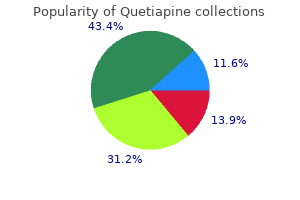
300 mg quetiapine order with amex
Tumor Confined to the Intramural Ureter A second kind of case is tumor in the intramural ureter. The failure rate of ureteroscopic therapy was 24% with 19% present process subsequent nephroureterectomy. There was, however, appreciable bias for favorable tumor traits (unifocal, low grade, and small tumor size). As with any urothelial most cancers, crucial prognostic indicator for tumor recurrence was grade. The upper tract recurrence fee and disease-free survival were worse with higher-grade tumors. The literature reveals the long-term feasibility of the ureteroscopic method, however issues over the high fee of ipsilateral recurrences stay. Patients must be counseled within the want for lifetime follow-up and possible remedy of ipsilateral recurrence. The complication charges appeared to have dropped in additional up to date sequence, most likely related to smaller endoscopes, improved laser vitality sources, and refinements in endoscopic methods. Two major issues of the ureteroscopic strategy are the accuracy of ureteroscopic biopsies and the constraints of biopsies, particularly with regard to staging. Retrospective reviews of patients who underwent ureteroscopic biopsy adopted by nephroureterectomy found the accuracy of ureteroscopic diagnosis to be 89% to 94% and the pathological grading to match the open surgical method in 70% to 92% (Guarnizo et al. A final concern is whether ureteroscopy promotes progression or unfold of disease to different urothelial surfaces or metastatic websites. There have been reports of increased tumor look in refluxing ureters of patients with bladder tumors (de Torres Mateos et al. However, Kulp and Bagley (1994) reported on 13 patients who underwent multiple ureteroscopic remedies adopted by nephroureterectomy; they found no uncommon propagation of cancer within the specimens. Concerns that ureteroscopy could promote metastatic unfold were raised by Lim et al. Three basic approaches can be utilized for tumor ablation: bulk excision with ablation of the base, resection of the tumor to its base, and diagnostic biopsy adopted by ablation with electrocautery or laser power sources. Specimens are frequently minute and ought to be positioned in fixative at once and are specifically labeled for either histologic or cytologic evaluation (Tawfiek et al. Next, the tumor base is treated with both electrocautery or laser vitality sources.
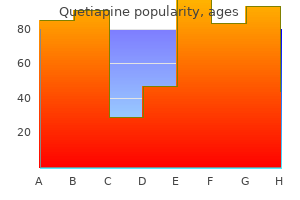
Buy 300 mg quetiapine
If these remain positive despite a adverse bladder analysis or after profitable treatment of the bladder, then one should proceed to evaluating extravesical sites and contemplate repeat bladder analysis at the identical time. Ureteroscopy may additionally be done at this time to permit for direct visualization of the upper urinary tracts, or accomplished once the positive cytology is lateralized. Some of the authors have made two modifications to the protocol as described in prior research. Another major change has been to instill the gemcitabine at the time of nephroureterectomy. In instances of intraoperative chemotherapy instillation, the following steps are taken. A 2- or 3-way urinary catheter is positioned either on the sterile area or sterilely off the field, and the bladder is drained, after which the chemotherapy may be administered intravesically earlier than the surgery is began. A clamp is placed on the outflow (also on inflow if using a 3-way catheter; we do this when the catheter is positioned off the sterile field to permit the nursing circulator to easily irrigate the bladder using attached irrigation tubing). The anesthesia staff is requested to reduce intravenous fluid administration as a result of the bladder will be clamped for 1 to 2 hours. After surgery has began, once the ureter is clipped below the level of the tumor and after a minimal of 1 and up to 2 hours of dwell time, the circulator can take away the clamp(s) and drain the bladder. By the time surgical dissection reaches the distal ureter and bladder cuff, the bladder has been totally drained of the chemotherapy. In addition, the utilization of the 3-way catheter permits further bladder irrigation to wash out any attainable residual chemotherapy, and after closure of the cystotomy, confirmation of a watertight closure of the cystotomy web site. There is controversy over the right administration of this discovering, which positively confers a risk of disease development but might require a long follow-up time to show a recurrence. The authors showed that conversion from constructive to negative was associated with improved survival. Expectant Management There is very little information on the position of energetic surveillance. Some latest studies have proven that this approach may be considered in chosen cases. Adjuvant Topical Therapy Adjuvant Intravesical Topical Chemotherapy After Nephroureterectomy to Decrease Bladder Recurrence.
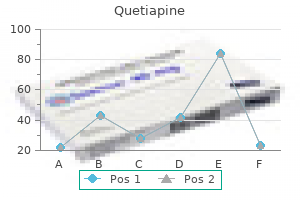
Generic 300 mg quetiapine with amex
This may be achieved by ligating the renal vein medial to the take-off of the adrenal vein. Regional lymph nodes could additionally be removed, and a full hilar or retroperitoneal dissection could be carried out if deemed essential. Excision of part of the adjacent organs, such because the diaphragm, pancreas, liver, spleen, and bowel, could be accomplished if needed (Molina et al. Similar results were noticed in research with long-term follow-up during which the 10-year recurrence-free, cancer-specific, and total survivals were 94%, 97%, and 76% for laparoscopic nephrectomy in contrast with 87%, 86%, and 58% for open surgery, respectively (Permpongkosol et al. Similarly, a examine of laparoscopic nephrectomy for renal cell carcinoma adopted for 10 years or extra showed a 10-year recurrence-free, cancer-specific, and total survival of 86%, 92%, and 65%, respectively (Berger et al. Retroperitoneal Procedure the affected person is positioned, and trocars are positioned for retroperitoneal access as previously described. After identification of the psoas muscle and tendon, the retroperitoneal area anterior to the muscle is developed. Elevation of the ureter permits the visualization and subsequent elevation of the lower pole of the kidney. The arterial pulsation may be indirectly visualized through overlying connective tissue. A gentle layer-by-layer dissection allows the renal vessels to come extra instantly into view. Use of the right-angle dissector allows the artery and vein to be circumferentially freed from the encompassing tissue, and the endovascular stapler or clips are used to divide the artery and vein sequentially. During surgery on the left kidney, a lumbar vein usually requires dissection, ligation, and division to allow direct entry to the renal hilum. Once the renal hilum is ligated, the posterior dissection is carried in a cephalad path to the higher pole followed by dissection of the lateral and anterior elements of the kidney. Results Laparoscopic radical nephrectomy presents minimally invasive advantages with related long-term oncologic outcomes in contrast with open surgery (Campbell et al.
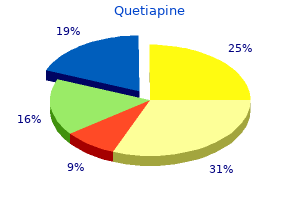
Cheap 100 mg quetiapine otc
Ongoing trials using stem cells within the remedy of stress incontinence in ladies and remedy of post-prostatectomy incontinence in men could one day translate into therapy choices for the neurogenic population. The urologic rehabilitation of patients with spinal dysraphism depends totally on medical administration and intravesical injection of onabotulinumtoxinA, with the selective use of augmentation enterocystoplasty or urinary diversion if failure happens. A latest analysis of individuals being adopted long run for myelomeningocele (20-year follow-up) found that 7 sufferers (13% of the unique 52 followed) had unilateral renal dysfunction and eight (15%) had bilateral total renal dysfunction. Those with bilateral dysfunction had a significantly greater threat of detrusor overactivity during childhood urodynamic analysis (63%) compared with these with regular operate (24%). Eight sufferers required surgical intervention sometime during the course of their condition. Nine used common Chapter 116 tethered wire release, medical symptoms had been evaluated at 1 and three months after surgery as properly as every 6 months thereafter. The most common causes of tethered wire included lipomyelomeningocele (10%), tight filum (10%), lumbosacral lipoma (14%), intradural tumor (10%), and previous surgery (7%). Symptomaticpresentation included diffuse ache and paresthesias in each decrease extremities (45%) or perineum (62%). Lower extremity weak spot was famous in sufferers with gait disturbances (59%) and bladder dysfunction (48%). Multilevel laminectomy accompanied by duraplasty (30% of patients) was performed as the first intervention. At 18 months postoperatively, 47% of the sufferers with urinary signs had improvement in these symptoms, 69% had enchancment in the lower extremity weakness, and 79% had improved painful dysesthesias. The majority of patients demonstrated improvement inside 6 months of surgical procedure (96%). Recent emphasis on transitional features of care from childhood to adulthood has centered on the need for meticulous follow-up and optimization of bladder and renal function in gentle of social stigma, patient issues, independence, and likewise bowel-related dysfunction. Consensus agreement stresses the need for established algorithmic approaches for follow-up inclusive of annual surveillance for early identification of urinary tract deterioration. These assessments ought to embrace renal and bladder ultrasonography and urodynamics when indicated (by symptomatic change or clinical physical examination finding). In addition, serum creatinine and renal scintigraphy could additionally be performed when upper tract changes are suspected. Goals of remedy include discount in detrusor pressure and maintenance of bladder compliance and social continence (de Kort et al.
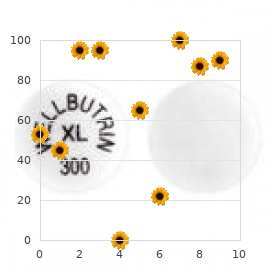
Buy quetiapine 100 mg with amex
Obstruction of either the portal circulation from the inferior mesenteric vein or the systemic circulation from the inferior rectal veins may end up in dilation of the venous plexus and hemorrhoid formation. The pudendal nerve travels with the inner pudendal vessels in Alcock canal to innervate the perineum. Posteriorly, the rectal branches supply the external sphincter and supply sensation to the perianal pores and skin. The widespread iliac arteries course anteriorly to the common iliac veins and break up into an external and inside branch at the stage of the sacroiliac joint. The external iliac artery sits anterolateral to the vein and on top of the iliopsoas muscle. It eventually crosses underneath the inguinal ligament, where it becomes the femoral artery. Distal branches of the exterior iliac artery could additionally be encountered during pelvic lymph node dissection, including the inferior epigastric artery (which leaves the artery proximal to the inguinal ligament and travels to the rectus muscle) and the deep circumflex iliac and pubic branches. It ultimately drains into the interior iliac vein, together with a quantity of inferior vesical veins. The cremasteric artery additionally branches from the inferior epigastric artery, the place it travels with the spermatic wire. Accessory obturator vessels could additionally be encountered during pelvic lymph node dissection as they branch from the inferior epigastric vessels and travel into the obturator fossa. The inside iliac (hypogastric) artery travels posteriorly after branching from the widespread iliac artery to supply the deep pelvis. The anterior trunk offers off a number of branches: the umbilical artery, the obturator artery, the middle rectal and inferior vesical artery, the internal pudendal artery, and then the inferior gluteal. The superior vesical artery arises from the umbilical artery proximally and provides the bladder together with the inferior vesical artery. The artery of the vas deferens also comes from a branch of the umbilical artery and joins the cremasteric and testicular arteries in the spermatic twine, providing an additional blood supply to the testicle. Pelvic Lymphatics the drainage from the pelvic viscera contains the iliac lymph nodes and its tributaries.
Real Experiences: Customer Reviews on Quetiapine
Anog, 58 years: Mild postural hypotension with systolic pressure larger than eighty mm Hg is acceptable (Kinney et al.
Amul, 41 years: Loening S, Narayana A, Yoder L, et al: Factors influencing the recurrence price of bladder most cancers, J Urol 123:29�31, 1980.
Kliff, 42 years: The use of diaries often helps patients understand their pattern of urination and is extra accurate than recall (Larsson et al.
Hauke, 32 years: The celiac arterial trunk, its branches, and related autonomic nervous plexus are also nicely demonstrated.
Ford, 60 years: Haab F, Stewart L, Dwyer P: Darifenacin, an M3 selective receptor antagonist, is an efficient and well-tolerated once every day treatment for overactive bladder, Eur Urol 45(4):420, 2004.
Tippler, 28 years: Data exist already displaying the efficacy of mitomycin-C, and most just lately, gemcitabine (Messing et al.
9 of 10 - Review by N. Dudley
Votes: 67 votes
Total customer reviews: 67
References
- The AIM-HIGH Investigators. Niacin in patients with low HDL cholesterol levels receiving intensive statin therapy. N Engl J Med 2011;365:2255-2267.
- Thurberg BL, Fallon JT, Mitchell R, et al. Cardiac microvascular pathology in Fabry disease: evaluation of endomyocardial biopsies before and after enzyme replacement therapy. Circulation 2009;119(19):2561-2567.
- Bainbridge D, Martin JE, Cheng DC: Patient-controlled versus nurse-controlled analgesia after cardiac surgeryóa meta-analysis, Can J Anaesth 53:492-499, 2006.
- Amarenco P, Cohen A, Tzourio C, et al: Atherosclerotic disease of the aortic arch and the risk of ischemic stroke, N Engl J Med 331:1474, 1994.
- Clements B, Warner JO, Shinebourne EA. Congenital bronchopulmonary vascular malformations: clinical application of a simple anatomical approach in 25 cases. Thorax 1987;42:409-16.
- Bae ON. Targeting von Willebrand Factor as a novel anti-platelet therapy; application of ARC1779, an anti-vWF aptamer, against thrombotic risk. Arch Pharm Res 2012;35:1693-9.

